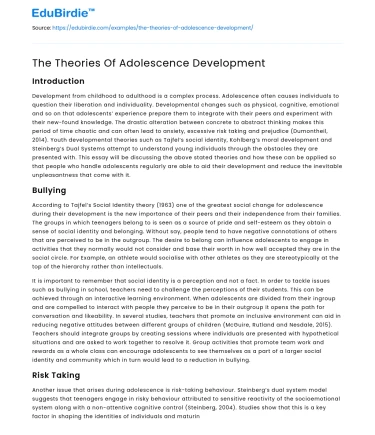Table of contents
- Introduction
- Bullying
- Risk Taking
- Morality
Introduction
Development from childhood to adulthood is a complex process. Adolescence often causes individuals to question their liberation and individuality. Developmental changes such as physical, cognitive, emotional and so on that adolescents’ experience prepare them to integrate with their peers and experiment with their new-found knowledge. The drastic alteration between concrete to abstract thinking makes this period of time chaotic and can often lead to anxiety, excessive risk taking and prejudice (Dumontheil, 2014). Youth developmental theories such as Tajfel’s social identity, Kohlberg’s moral development and Steinberg’s Dual Systems attempt to understand young individuals through the obstacles they are presented with. This essay will be discussing the above stated theories and how these can be applied so that people who handle adolescents regularly are able to aid their development and reduce the inevitable unpleasantness that come with it.
Bullying
According to Tajfel’s Social Identity theory (1963) one of the greatest social change for adolescence during their development is the new importance of their peers and their independence from their families. The groups in which teenagers belong to is seen as a source of pride and self-esteem as they obtain a sense of social identity and belonging. Without say, people tend to have negative connotations of others that are perceived to be in the outgroup. The desire to belong can influence adolescents to engage in activities that they normally would not consider and base their worth in how well accepted they are in the social circle. For Example, an athlete would socialise with other athletes as they are stereotypically at the top of the hierarchy rather than intellectuals.
It is important to remember that social identity is a perception and not a fact. In order to tackle issues such as bullying in school, teachers need to challenge the perceptions of their students. This can be achieved through an interactive learning environment. When adolescents are divided from their ingroup and are compelled to interact with people they perceive to be in their outgroup it opens the path for conversation and likeability. In several studies, teachers that promote an inclusive environment can aid in reducing negative attitudes between different groups of children (McGuire, Rutland and Nesdale, 2015). Teachers should integrate groups by creating sessions where individuals are presented with hypothetical situations and are asked to work together to resolve it. Group activities that promote team work and rewards as a whole class can encourage adolescents to see themselves as a part of a larger social identity and community which in turn would lead to a reduction in bullying.
Risk Taking
Another issue that arises during adolescence is risk-taking behaviour. Steinberg’s dual system model suggests that teenagers engage in risky behaviour attributed to sensitive reactivity of the socioemotional system along with a non-attentive cognitive control (Steinberg, 2004). Studies show that this is a key factor in shaping the identities of individuals and maturing their newly found decision-making skills (Jessor, 1993).
Despite this, it can lead to adolescents practising unsafe sex, abusing drugs and using maladaptive behaviours. Parents should be able to communicate with their children in a constructive manner about the decision-making processes; the goal is to allow them to weigh the benefits and drawbacks of a situation without feeling as if they are being disciplined.
Nonetheless, Adolescents often consider their parents the enemy and so to combat this issues schools should promote the idea of peer educators. The peer educators interact with the adolescents as equals and provide a safe space to communicate about pressing issues such as their sexuality and sociability. The peer educator although older is recognised as an individual in the adolescents’ ingroup and is considered relatable. Weekly hourly sessions should be implemented in schools per classroom where students can combat issues such as unsafe sex, body image, drugs, which are conversations that adolescence might not be comfortable having with an adult or their parents. This way adolescents make informed decisions of the risks they are willing to take.
Moreover, it is possible to achieve risk-taking behaviour without it harming the individual. A risk is considered anything that goes beyond a person’s comfort zone or abilities. There are positive pathways that can satisfy this urge such as performing in school plays or learning a new instrument (Ponton, 1998). Parents should encourage adolescents to perform such tasks and school curriculums should involve innovative extracurricular activities where they are able to explore and shape their identities.
Morality
Involvement in peer groups also allow the development of individual morality. The process of moral development can be frustrating as youth explore how they contrast from their parents and often question authority. According to Kohlberg’s moral development theory (1976) , adolescents transition from the preconventional (egocentric behaviour) to the conventional stage where they compare their actions according to societies views and expectations. In one study, participants were asked how they would react to hypothetical situations. It was found that 18-year old’s still think rather egocentrically, having their own self-interest in mind whereas 22-year old’s thought more about what was socially acceptable and thinking becomes less self-centred (Jadack, 1995).
In order to combat risk-taking behaviour such as smoking governments should promote the safety of adolescents in terms of their own self-interest rather than what is socially acceptable. When advertising the harm of smoking to adolescents, interventions should focus on effects such as lung cancer that can harm the person individually. If adolescents were to be told smoking causes increase in taxes for the population due to larger medical bills or that it can reduce the well-being of those close to them, they are less likely to quit.






 Stuck on your essay?
Stuck on your essay?

